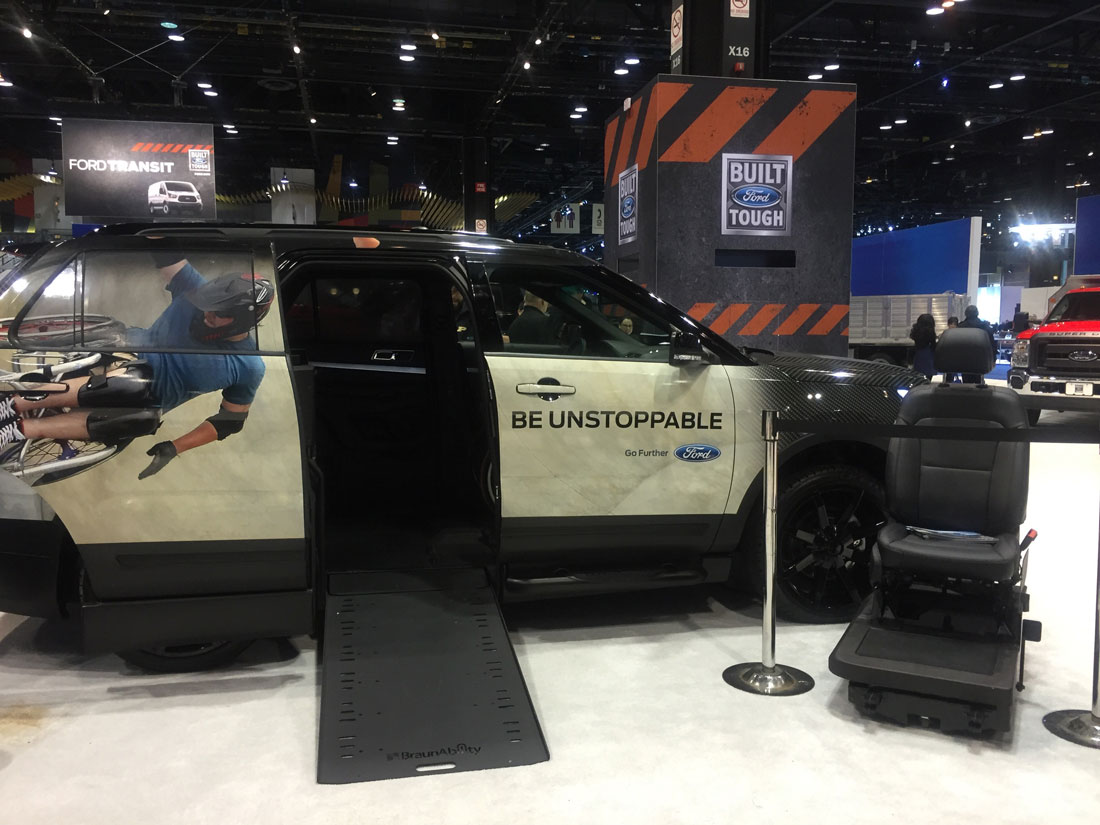By Shen Wu Tan
A world leading company in manufacturing accessible vehicles showcased the world’s first wheelchair-accessible SUV at the Chicago Auto Show last week. BraunAbility MXV, a converted 2016 Ford Explorer, enables customers with compromised mobility to comfortably drive or ride as passengers.
The new vehicle provides mobility and freedom to costumers in wheelchairs to perform daily activities, said Joseph Young, the BraunAbility area sales manager for Mid-Atlantic consumer sales.
“If they wanted to go to the grocery stores, if they wanted to go see friends or if they just wanted to go somewhere on their own, we’re allowing them to have the accessibility to the community and society like a normal consumer would,” Young said.
Plans to produce the first wheelchair-accessible SUV started about two and half years ago when BraunAbility recognized that many of its customers wanted more mobility vehicle options.
“A lot of our customer engagement was telling us that there was a segment of customers that wanted something other than a mini van – a pick up truck, sport utility vehicle, something that has towing capacity and different styling,” said Jim Probst, BraunAbility’s director of product portfolio.
BraunAbility then teamed up with Ford to transform the Ford Explorer, a top selling SUV for years, into a wheelchair-accessible vehicle.
The converted Explorer will be sold at more than 200 mobility equipment dealerships. It includes features such as removable driver and passenger seats, an in-floor ramp, a sliding shifter, a towing package and a key fob that activates the doors and ramp.
[vimeo 156454368 w=474]
Mike DeLancey, an Iraqi war veteran, was the first person to own a BraunAbility MXV. While in Haditha, Iraq, a bullet from an enemy sniper struck DeLancey in the left shoulder that shattered his vertebrae and left him paralyzed. After the incident, DeLancey began rehabilitation.
DeLancey has owned his BraunAbility MXV since September.
“I have a trailer. And I do have a lot of different sports toys and things like that I like to use the trailer with,” said DeLancey. “And the van doesn’t really have any towing capacity whereas the Ford is the first one to do that.”
Jesse Billauer, the CEO of Life Rolls On, said he is excited to be getting a BraunAbility MXV in the next month or two. Life Rolls On, an organization dedicated to improving the quality of life for those affected with spinal cord injuries, is a sponsor of BraunAbility MXV.
Billauer broke his neck and severed his spinal cord during a surfing accident in 1996 at the age of 17. Prior to the accident, he was on the verge of becoming a professional surfer.
He now owns a Dodge Durango RT. To drive this car, his caregiver lifts him out of his wheelchair and into the driver’s seat. With the MXV, Billauer can access and drive the car from his wheelchair.
“With a vehicle like this, not only does it bring an opportunity for me to be more independent, but also to bring a lot of style,” said Billauer.

However, the luxury of adding accessible features to the SUV will cost customers extra.
Compared to a non-accessible Ford Explorer, the BraunAbility MXV costs about twice as much. A 2016 Ford Explorer costs about $31,000; a BraunAbility MXV starts at about $60,000.
According to Eric Lipp, founder of the Open Doors Organization, a wheelchair-accessible Ford Explorer should not cost more than a non-accessible Ford Explorer.
Lipp founded Open Doors Organization, a centralized dispatch for accessible taxis, in 2000 after he discovered he had a disease that left a tumor on his spinal cord.
As someone familiar with mobility vehicles, Lipp said the new wheelchair-accessible SUV is not breakthrough technology nor a vehicle built purposefully for inclusivity and accessibility.
“They are taking a car and making it accessible,” Lipp said. “Anybody can do what they are doing. When you’re talking about a purposeful, inclusive-built car, you’re talking about something like the MV-1, which is a purposeful vehicle under ADA specs. That car is just a Ford Explorer that they are adding a ramp to through BraunAbility.”
As mobility equipment continues to progress, Ford recognizes this trend and the demand for accessible vehicles, Lipp said. “We are moving forward. Ford clearly sees that it is going to need to compete with these other companies that are making their own [accessible] vehicles.”
Despite higher costs and debate about the SUV’s accessibility standards, the BraunAbility MXV offers another independent transportation option for customers in wheelchairs.


